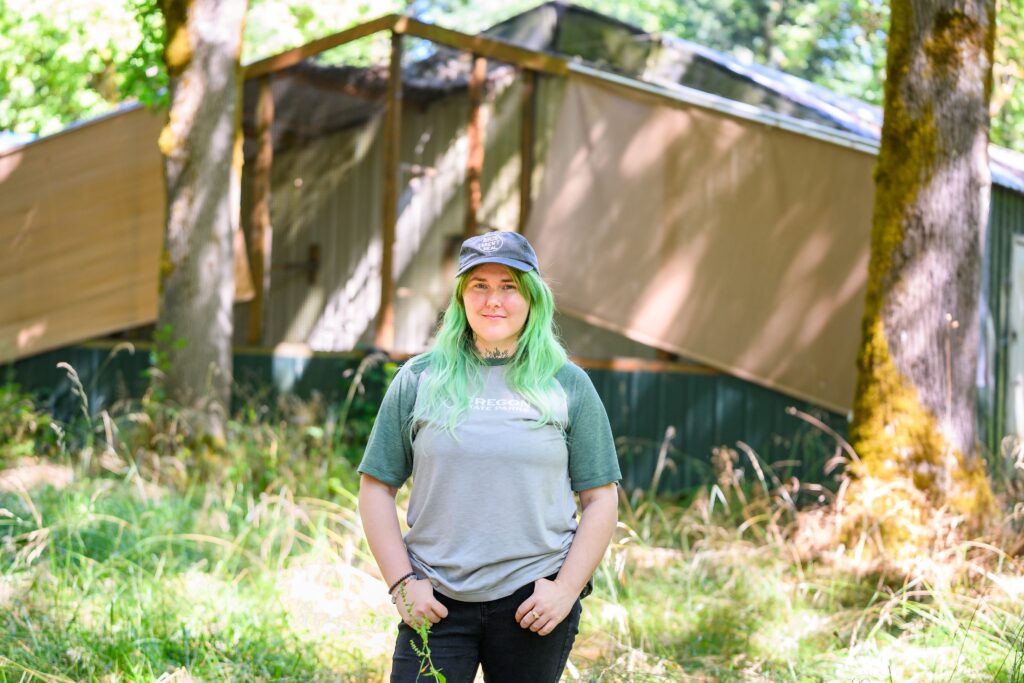Lexie Echols
received an urgent call from her sister-in-law in late May. Driving through green pastures southeast of Corvallis, something had caught her attention.
A barn owl
was trapped on a barbed wire fence.
They took swift action. Echols brought a towel, box and work gloves to the scene, and they worked together to detach the owl from the fence.
“To be honest, I am scared of birds,” Echols said. “But seeing the owl in pain and suffering, the fear that I had didn’t matter at that point.”
Echols contacted the
Chintimini Wildlife Center
, an animal rescue and rehabilitation center near Corvallis. After a couple of hours without an answer back, she made the decision to drive to the center.
During the whole process, Echols recorded and posted her owl rescue on TikTok. Little did she know that her videos would go viral and reach over 42 million viewers globally. Echols directed her viewers to the center’s donation page, bringing in $50,000 over the past two months, which helped the center through its busy summer season.
“I think the reason it got so much attention is because of the owl’s sweet face,” Echols said. “I think just seeing the owl … be so willing to let us help him was the reason why people stopped and watched, and why it had such an emotional response for people.”
Amid the dire rescue, the bird was unusually quiet, Echols noticed. It “definitely didn’t have any fight.” In videos, it nuzzled into the box that Echols and her sister-in-law provided.
When Wildlife Rehabilitation Specialist Zo Chapman saw the fledgling barn owl, they said it was in a “very sad condition.” Chapman rated the owl a one out of five on their health scale, one being the lowest score they assign to patients.
The owl’s gender remains a mystery, because male and female owls don’t have obvious physical differences, Chapman said. The staff also don’t name patients to prevent becoming emotionally attached.
The owl was starving and dehydrated. Its injuries consisted of two punctures on the left wing, minor ligament damage and a scrape on the right foot.
This is not a unique situation. This year to date, the center has taken in 38 barn owls, and it’s not uncommon for animals to get trapped in barbed wire.
“This owl was in such rough shape that we weren’t sure if it would survive the first night,” Chapman said.
Typically, barn owls are high-stress birds, Chapman explained.
“We would expect a healthy barn owl to be screaming at us from the second we started looking at it, especially during handling,” Chapman said, but this owl wasn’t.
Chintimini staff described taking care of the owl as tricky. They had to feed it through a tube, and a veterinarian performed several surgeries. In the beginning, it received three daily check-ins, which soon reduced to two.
The owl’s fame was unexpected.
“It was overwhelming at first,” said Development Coordinator Heather Gibons.
The wildlife center posted updates about the barn owl, solicited donations and designed an owl
T-shirt
, including the slogan “No Hoots, Only Screams,” inspired by a fan comment.
“With Chintimini adding in all of their updates, now everybody’s just emotionally invested as I am,” Echols said.
Echols worked with Birdfy, a bird feeder company, to raise donations for the Chintimini Wildlife Center. For 72 hours, Birdfy donated $1 to the center for every comment made under Echols’ Instagram video.
The center received donations from 50 states and 20 other countries because of the owl, Gibons estimated.
The center relies mainly on donations, and the increase in support “really helped,” she said.
Due to economic shifts, there have been fewer donations to the wildlife center this year, Gibons said. The center has received about $350,000 in donations on average over the past four years. In addition to paying for staff salaries, facilities and education programming, the center spends about $110,000 on rehabilitating wildlife patients, Gibons said. It cares for more than 2,000 animals per year.
By June 30, the owl had healed sufficiently to be moved outdoors. The owl is on track for release back into the wild by the end of summer, Gibons said.
However, before its release, caretakers must ensure the owl can fly quietly to attack prey, so it can sustain itself.
The owl is very vocal now, too. It releases screeches during its checkups, as captured on Chintimini’s Instagram.
“We want to be screamed at,” Chapman said. “So seeing that return is very rewarding.”
–- Lina Corona, West Linn High School
–- Neea Mende, Ida B. Wells High School
This story was produced by student reporters as part of the High School Journalism Institute, an annual collaboration among The Oregonian/OregonLive, Oregon State University and other Oregon media organizations. For more information or to support the program, go to
oregonlive.com/hsji
.
High School Journalism Institute 2025
-
Bridges Program in Corvallis changes its ‘last resort’ narrative, gives students a second chance
-
Students sharpen skills at Oregon State creamery to prepare for dairy jobs
-
Commentary: School security measures go too far
-
Oregon State professor teaches punk, horror — and Taylor Swift
-
Corvallis roller derby was in a jam. Now it’s thriving





More Stories
Screaming is a good sign: How a TikTok-famous rescued barn owl is doing now
Screaming is a good sign: How a TikTok-famous rescued barn owl is doing now
Screaming is a good sign: How a TikTok-famous rescued barn owl is doing now